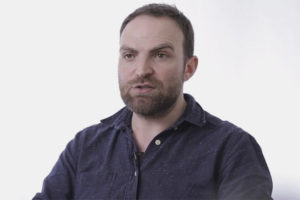Dyslexia
Developmental psychologist Uta Frith on the detection of dyslexia in children, difficulties with sound recogni...
How common it is to change the order of the subject and the verb when asking a question? What means exist to ask WH(ere) and WH(at) questions in different languages? What are some of the pressing issues in the linguistic study of questions? These and other questions are answered by Harvard linguistics professor, Maria Polinsky.
Many ways in which we use language, but probably one of the most prominent ones, is to ask questions, to ask for information. And so, it’s obvious that it’s built into a natural language that we can ask questions using that language. And no matter what language you speak, you can always ask, “When did you go there?” or, “Who did you see?” or, “Would you like to do this or that?”. So this is what questions are about.
The question about questions has to do with the range of variation in natural language in terms of how those questions can be expressed. There are about 7000 languages in the world and, of course, we only have information, let’s say, about 200 at best. So when people say, “most languages do X” that’s a very rabid exaggeration, because “most” means probably the 50 that I know about.
There are two ways to find out what other languages do. You can either just go around and check each and every of the 7000 languages, that will take a while, and I probably won’t be around to get an answer. Or we can combine what we know from linguistic theory with our observations on linguistic facts and try to bring them together in building some kind of a picture of a cross-linguistic variation. So both approaches are, of course, quite valid, and questions are particularly important in that regard.
There are essentially three types of questions that every language has: so-called polar questions, content questions and “what-the-hell” questions. So let’s start with “what-the-hell” questions. In English these questions take their name from “What the hell are you doing?” or “Where on earth are you going?”. And this is the sort of expressions which probably shouldn’t be called questions, because when you say, “What the hell are you doing?” you’re not asking for an answer, you’re just expressing that you’re unhappy. These questions are very varied, but again, every language has a way of expressing my unhappiness and sometimes it’s in the form of questions.
The other two are polar questions and WH questions (Yes/No questions and content questions). So Yes/No questions are questions like “Are you going there tomorrow?” or “Did you do that?”. English, in fact, is quite unusual, because in order to ask a polar question in English, you have to change the order of the subject and the verb. So in English we’ll say, “I went there yesterday”, but then we’ll say, “Did you go there yesterday?”. This is called subject-auxiliary inversion (SAI), which has received a lot of accounts and a lot of explanations in theoretical linguistic literature, which is completely disproportionate to how rare it is. Out of the 1000 languages that Matt Dryer studied, there are probably 13 that have the subject-auxiliary inversion. So it’s kind of remarkable that such a secondary character in linguistic literature has received so much attention.
Mostly, when you want to ask a polar question, you either just change your intonation or you put a little question particle in the end. And the prosody or intonation is particularly important, because typically people say declarative sentence with their voice falling down at the end. Something like, “they lived happily thereafter”. And if they ask a question, then there is a rise — “they lived happily thereafter?”, something like that. You can do that in pretty much any language.
The expectation is that we use the fall at the end of the declarative and the rise at the end of the question, because the rise means: “I’m not done, I want more information”. And so that’s used as the account as to why we normally see a rise in polar questions. But, as everything in linguistics, there are exceptions to this rule, and there are quite a few languages which actually do the opposite. Native American language Chickasaw uses the rise for normal declaratives, and it uses the fall for questions. So it’ll be “they lived happily ever after [with a rise at the end]” and the question will be “they lived happily thereafter [with a fall at the end]”. More importantly, there are a couple of American dialects and Belfast uptalk (Belfast English), which also use the same. So, probably the most famous American dialect, which does the opposite, using the rise for declaratives and the fall for interrogatives, is what’s called “Valley Girl” talk, where they all say, “so I’m going to the store [with a rise at the end]”, and then, if you ask a question, you say, “Where is the salon [with a fall at the end] ?”. So that’s an indication that we really need to know what exactly the prosody is in a particular language, but the clear generalization seems to be that whatever the contour of your declarative is, your question will have the opposite of that.
Now, if we now go to the WH questions, there are essentially three strategies that people use in asking content questions, or WH questions like, “What did you eat?” or ”What did you read?”. The most obvious one is we take the WH-word – what, where, when, who, and so on – and put it in the front. And again, this is something we are very used to from English – so, “Who did you invite?”, “Where did you go?”, “When was your birthday?” and so on. If we look at the distribution of linguistic types, it actually turns out that this is probably the least common strategy. Just like with the subject-auxiliary inversion, where English was in the minority, this one is also in the minority.
Much more common strategy is to put the WH-word where it should be, if you were answering the question. Something like “You went where yesterday?”. That’s called WH-in-situ questions. Questions like that are found in Chinese, in Uzbek, in Japanese, and so on — there are lots and lots of languages that do that. And then finally, probably the most remarkable or most unusual strategy of asking WH questions is to make the WH-word into a verb or predicate. So instead of saying, “What did you do?” it will be something like, “Your doing was what?”. And this is the strategy that’s really hard for us, who speak in a European language, to visualize, but that’s extremely common, and it’s found in quite a few languages. We do see it across the world in Austronesian languages, we find it in Mayan, we find it in some languages of Africa.
And this strategy is particularly important to linguistic theory, because it basically tells us something extremely important about the nature of those content WH-words, which is that they indicate focus. Focus is something that the sentence is about, the new information. Because WH-word is asking for your information, it does correspond to the place of the new information. And there is no better place for new information in the sentence than the predicate. In fact, if we were thinking on how to build a natural language, to build it from scratch, we would probably want to have WH-predicates all over, and that would languages like English or Japanese somewhere in the minority.
So I’ve given you three different strategies of asking content questions. Then the obvious question that we want to ask, going back to the 7000 languages, is whether or not we can find any correlations, which will allow us to predict which languages will use which particular strategies. And I can’t say that we’ve identified all the correlations to the point that it’s fool-proof, but there’ve been a couple of things which have been extremely promising.
One of the correlations is that if you have a language that uses WH-words in-situ, or in place, like in Japanese, then this language more likely than not is going to have what’s called “question particles”. So, if you speak Japanese, you will know that in Japanese, when you ask a question, you put your WH-word content word where it belongs, and then at the end of the question you put “ka”. So it’ll be something like, “Yesterday you what saw ka? “ — that’s going to be the order. And so this “ka” says: “I’m a question“. And this is what typically allows us to put WH-words in place. That’s one of the correlations. You go look at languages, which have question particles, you find question particles, you can say – more likely that not this language will use WH-questions in place.
Another correlation, which we find quite a bit, has to do with the word order. So, generally, languages are divided into three main subtypes, depending on what their word order is: languages like English or Russian, where we start with the subject, then we have the verb, then we have the object; languages like Japanese, where we start with the subject, then we have the object, then we have the verb at the end (and those languages are the majority); and then, finally, languages where the verb is first — languages like that are represented by Irish, or Mayan languages, or Hawaiian and Berber, for example. In those languages, in the ones that start with a verb, it’s very common to have predicate WH-questions. Again, we see a correlation, and the correlation may have something to do with the fact that the predicative information goes first.
So we’ve established those three subtypes and we’ve established some correlations, and the next thing that we need to do in understanding the theory of WH questions cross-linguistically is to see what our WH-words, content question words are synonymous with. Again, in familiar languages, words like “who” and “what” and “where” stand by themselves, stand on their own. But there are plenty of languages where one and the same word can be used to say “who” and “somebody”. Or “what” and “something”, “where” and “somewhere”. So these languages are known as languages with indeterminance and, although we know a fair amount about those languages, we still need to find out what exactly it is that will determine the distribution of those ambiguities, and how they will interact with WH-words in WH questions. So this is probably going to be the next frontier in the study of questions.

Developmental psychologist Uta Frith on the detection of dyslexia in children, difficulties with sound recogni...

Psychologist Helen Tager-Flusberg on theory of mind, comorbidity, and symptoms of autism

Psychologist Ben Ambridge on the difficulties with learning languages, a critical period for a new language ac...